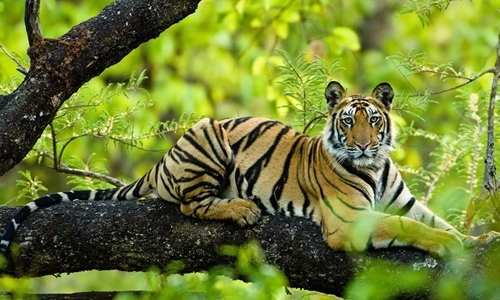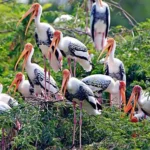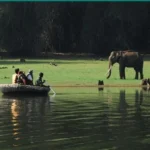Bandhavgarh National Park, located in the Umaria district of Madhya Pradesh, is one of India’s premier wildlife destinations and a renowned sanctuary for the majestic Bengal tiger. Known for its dense tiger population, Bandhavgarh offers an exceptional opportunity to witness these magnificent creatures in their natural habitat, along with a diverse range of other wildlife. The park is also steeped in history, with ancient caves, temples, and the iconic Bandhavgarh Fort adding to its allure.
Choosing the best time to visit Bandhavgarh is key to enhancing your wildlife experience, as each season brings unique elements to the landscape, affecting visibility, animal behavior, and overall accessibility. Here’s a detailed guide to help you pick the ideal season for your trip to Bandhavgarh National Park.

October to February: The Cool Winter Season
Temperature Range: 8°C to 22°C
Why Visit? Pleasant weather, high visibility, active wildlife, ideal for photography
Winter, from October to February, is considered the most popular time to visit Bandhavgarh National Park. During these months, the temperature ranges from a chilly 8°C in the early mornings and evenings to a comfortable 22°C during the day, making it perfect for safari exploration. This cool weather not only ensures a comfortable experience but also increases wildlife visibility, as animals come out of the dense foliage into open spaces to bask in the sunlight.
In winter, the landscape of Bandhavgarh is at its most picturesque, with the dry vegetation providing excellent visibility through the forest. Animal sightings are frequent, as tigers, leopards, deer, and langurs are often spotted near water sources, which are fewer due to the dry weather. Birdwatchers, too, will find this season rewarding, as migratory birds such as the Malabar pied hornbill and steppe eagle flock to the park, adding vibrant colors to the landscape.
For photographers, winter offers ideal lighting conditions, with clear skies and soft sunlight. Early morning and late afternoon safaris are particularly productive, as these are the times when animals are most active. Since this is peak season, it’s advisable to book your safari tickets and accommodation in advance, as Bandhavgarh sees a surge in visitors during winter.
March to June: The Summer Season and Prime Tiger Spotting
Temperature Range: 25°C to 45°C
Why Visit? High chances of tiger sightings, fewer crowds, thrilling experience
Summer in Bandhavgarh, which spans from March to June, brings soaring temperatures that can reach up to 45°C in the afternoon. Despite the intense heat, summer is actually one of the best times for serious wildlife enthusiasts, particularly those keen on spotting the elusive Bengal tiger. The dry summer weather causes the park’s natural water sources to shrink, compelling animals to frequent the remaining water bodies, which are prime locations for tiger sightings.
During this season, tigers, leopards, and herbivores such as chital and sambar deer are often found cooling off by the water. The lack of thick foliage makes it easier to spot animals, as they seek open areas to rest or hydrate. Although the high temperatures may be challenging, early morning and late evening safaris allow you to avoid the peak heat while maximizing your chances of encountering Bandhavgarh’s famed wildlife.
For photographers, summer offers dramatic opportunities, especially around water sources where tigers can be seen playing, drinking, or resting. The crowds are typically thinner during this season due to the heat, allowing for a more exclusive wildlife experience. Just remember to bring plenty of water, light clothing, sunscreen, and a hat to protect yourself from the sun.
July to September: The Monsoon Season and Park Closure
Temperature Range: 20°C to 30°C
Why Visit? Lush green landscapes, rejuvenated forest, picturesque scenery
Monsoon arrives in Bandhavgarh around July and lasts until September, bringing life-giving rains that transform the landscape into a lush, green paradise. However, during this season, Bandhavgarh National Park remains closed to tourists as the heavy rains make the trails muddy and challenging to navigate. The park authorities take this time to carry out maintenance work, and the closure helps protect the park’s flora and fauna during the breeding season.
While visitors cannot enter the main park area during monsoon, the rejuvenated landscape of the surrounding buffer zones offers a beautiful setting for nature photography and birdwatching. The hills, valleys, and forested areas around the national park come alive, making it a tranquil time to explore the nearby regions if you’re looking to experience the lushness of monsoon without venturing into the core park area.
For those planning a monsoon visit, you can explore other parts of Madhya Pradesh, which offer similar natural beauty, but for a Bandhavgarh safari, you’ll have to wait until the park reopens in October.
Planning Your Safari Experience
Bandhavgarh National Park offers two safari options daily – one in the early morning and another in the late afternoon. Each safari lasts about 3-4 hours, and choosing the right slot can significantly affect your chances of spotting wildlife. Here’s what you should know before you book:
- Safari Zones: Bandhavgarh has several safari zones, including Tala, Magadhi, Khitauli, and Panpatha. The Tala zone is the oldest and most popular due to its high tiger density. However, all zones offer unique opportunities for wildlife sightings and natural beauty.
- Booking in Advance: To manage visitor numbers, Bandhavgarh operates a strict permit system. Make sure to book your safari permits well in advance, especially if you’re visiting during the peak winter season.
- Guides and Naturalists: Hiring an experienced guide or naturalist is highly recommended. They know the animal behavior patterns and the best spots to increase your chances of spotting tigers and other wildlife.
- Packing Essentials: Dress appropriately for the season – warm clothing for winter mornings and breathable, light clothing for summer. Essentials include binoculars, a camera, sunscreen, and insect repellent.
- Responsible Tourism: Always follow the park’s rules and respect the natural habitat. Avoid making noise or littering, as Bandhavgarh is an ecologically sensitive area where wildlife conservation is a priority.
Nearby Attractions
While Bandhavgarh National Park is the main attraction, the area is rich with cultural and historical sites. The ancient Bandhavgarh Fort, believed to be over 2,000 years old, sits atop a hill within the park and offers insights into the region’s history. The park is also home to numerous ancient caves, adorned with inscriptions and carvings dating back centuries, adding a fascinating cultural layer to the wildlife experience.
Conclusion
A visit to Bandhavgarh National Park is a mesmerizing journey into the heart of India’s wilderness, where you can witness the beauty and power of nature up close. Each season offers a unique perspective of the park, from the cool comfort and migratory birds of winter to the high-energy, tiger-rich scenes of summer.
Winter provides a balanced experience with high visibility and comfortable weather, while summer offers thrilling close encounters with the park’s famed tigers. Monsoon brings the landscape alive but is limited to buffer zone exploration. No matter when you choose to visit, Bandhavgarh’s rich biodiversity and striking landscapes promise an unforgettable experience for nature lovers and wildlife photographers alike.


